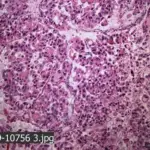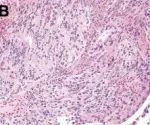Superior vena cava syndrome may be due to compression of the superior vena cava by a neoplasm.
What is the Pathology of Superior Vena Cava Syndrome?
The pathology of superior vena cava syndrome is:
-Etiology: The cause of superior vena cava syndrome is malignant mediastinal growths.
-Genes involved: NA.
-Pathogenesis: The sequence of events that lead to superior vena cava syndrome are as the result of consequent obstruction of superior vena cava by neoplastic invasion producing specific clinical manifestation.
-Morphology: Congested face.
-Histology: NA.
How does Superior Vena Cava Syndrome Present?
Patients with superior vena cava syndrome typically are males that present at an age range of 40 to 60 years old. The symptoms, features, and clinical findings associated with superior vena cava syndrome include cyanosis, head, arms, and neck vein dilatation.
How is Superior Vena Cava Syndrome Diagnosed?
Superior vena cava syndrome is diagnosed through imaging studies such as chest radiography, CT scan, MRI, and venography.
How is Superior Vena Cava Syndrome Treated?
Superior vena cava syndrome is treated through medical care which include chemotherapy, and oxygen supplementation. Surgical care may also be needed.
What is the Prognosis of Superior Vena Cava Syndrome?
The prognosis of superior vena cava syndrome is good. With proper management it is not associated with any mortality.



